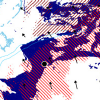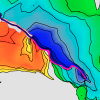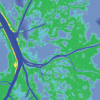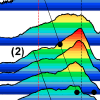
After the destruction of the Deepwater Horizon drilling platform during the spring of 2010, the northern Gulf of Mexico was threatened by an oil spill from the Macondo well. Emergency responders were concerned about oil transport in the nearshore, where it threatened immediately the fishing waters and coastline from Louisiana to Florida. In this region, oil movement was influenced by a continental shelf with varying width, the protruding Mississippi River delta, the marshes and bayou of southern Louisiana, and the shallow sounds and barrier islands that protect the coastline. Transport forecasts require physics-based computational models and high-resolution meshes that represent the circulation in deep water, on the continental shelf, and within the complex nearshore environment.
This work applies the coupled SWAN+ADCIRC model on a high-resolution computational mesh to simulate the current velocity field on the continental shelf, nearshore and marsh areas during the time that oil was visible on the surface of the Gulf. The SWAN+ADCIRC simulations account for the influence of tides, riverine discharge, winds and wind-driven waves. A highly-efficient Lagrangian particle transport model is employed to simulate the surface trajectories of the oil. The transport model accounts for dispersion and advection by wind and currents. Transport is evaluated using two week-long sequences of satellite images. During both periods, the SWAN+ADCIRC current fields alone appeared to be more successful moving the oil than when direct wind forcing was included. In addition, hypothetical oil transport is considered during two hurricane scenarios. Had a hurricane significantly impacted the areas, depending on its track, oil would have moved farther into the marshes of southern Louisiana or farther along the shelf toward Texas than actually occurred during the spill.
JC Dietrich, CJ Trahan, MT Howard, JG Fleming, RJ Weaver, S Tanaka, L Yu, RA Luettich Jr, CN Dawson, JJ Westerink, G Wells, A Lu, K Vega, A Kubach, KM Dresback, RL Kolar, C Kaiser, RR Twilley (2012). “Surface Trajectories of Oil Transport along the Northern Coastline of the Gulf of Mexico.” Continental Shelf Research, 41(1), 17-47, DOI:10.1016/j.csr.2012.03.015.
 The Lower Mississippi River protrudes into the Gulf of Mexico, and manmade levees line only the west bank for 55 km of the Lower Plaquemines section. Historically, sustained easterly winds from hurricanes have directed surge across Breton Sound, into the Mississippi River and against its west bank levee, allowing for surge to build and then propagate efficiently upriver and thus increase water levels past New Orleans. This case study applies a new and extensively validated basin- to channel-scale, high-resolution, unstructured-mesh ADvanced CIRCulation model to simulate a suite of historical and hypothetical storms under low to high river discharges. The results show that during hurricanes, (1) total water levels in the lower river south of Pointe à La Hache are only weakly dependent on river flow, and easterly wind-driven storm surge is generated on top of existing ambient strongly flow-dependent river stages, so the surge that propagates upriver reduces with increasing river flow; (2) natural levees and adjacent wetlands on the east and west banks in the Lower Plaquemines capture storm surge in the river, although not as effectively as the manmade levees on the west bank; and (3) the lowering of manmade levees along this Lower Plaquemines river section to their natural state, to allow storm surge to partially pass across the Mississippi River, will decrease storm surge upriver by 1 to 2 m between Pointe à La Hache and New Orleans, independent of river flow.
The Lower Mississippi River protrudes into the Gulf of Mexico, and manmade levees line only the west bank for 55 km of the Lower Plaquemines section. Historically, sustained easterly winds from hurricanes have directed surge across Breton Sound, into the Mississippi River and against its west bank levee, allowing for surge to build and then propagate efficiently upriver and thus increase water levels past New Orleans. This case study applies a new and extensively validated basin- to channel-scale, high-resolution, unstructured-mesh ADvanced CIRCulation model to simulate a suite of historical and hypothetical storms under low to high river discharges. The results show that during hurricanes, (1) total water levels in the lower river south of Pointe à La Hache are only weakly dependent on river flow, and easterly wind-driven storm surge is generated on top of existing ambient strongly flow-dependent river stages, so the surge that propagates upriver reduces with increasing river flow; (2) natural levees and adjacent wetlands on the east and west banks in the Lower Plaquemines capture storm surge in the river, although not as effectively as the manmade levees on the west bank; and (3) the lowering of manmade levees along this Lower Plaquemines river section to their natural state, to allow storm surge to partially pass across the Mississippi River, will decrease storm surge upriver by 1 to 2 m between Pointe à La Hache and New Orleans, independent of river flow.
 The Lower Mississippi River protrudes into the Gulf of Mexico, and manmade levees line only the west bank for 55 km of the Lower Plaquemines section. Historically, sustained easterly winds from hurricanes have directed surge across Breton Sound, into the Mississippi River and against its west bank levee, allowing for surge to build and then propagate efficiently upriver and thus increase water levels past New Orleans. This case study applies a new and extensively validated basin- to channel-scale, high-resolution, unstructured-mesh ADvanced CIRCulation model to simulate a suite of historical and hypothetical storms under low to high river discharges. The results show that during hurricanes, (1) total water levels in the lower river south of Pointe à La Hache are only weakly dependent on river flow, and easterly wind-driven storm surge is generated on top of existing ambient strongly flow-dependent river stages, so the surge that propagates upriver reduces with increasing river flow; (2) natural levees and adjacent wetlands on the east and west banks in the Lower Plaquemines capture storm surge in the river, although not as effectively as the manmade levees on the west bank; and (3) the lowering of manmade levees along this Lower Plaquemines river section to their natural state, to allow storm surge to partially pass across the Mississippi River, will decrease storm surge upriver by 1 to 2 m between Pointe à La Hache and New Orleans, independent of river flow.
The Lower Mississippi River protrudes into the Gulf of Mexico, and manmade levees line only the west bank for 55 km of the Lower Plaquemines section. Historically, sustained easterly winds from hurricanes have directed surge across Breton Sound, into the Mississippi River and against its west bank levee, allowing for surge to build and then propagate efficiently upriver and thus increase water levels past New Orleans. This case study applies a new and extensively validated basin- to channel-scale, high-resolution, unstructured-mesh ADvanced CIRCulation model to simulate a suite of historical and hypothetical storms under low to high river discharges. The results show that during hurricanes, (1) total water levels in the lower river south of Pointe à La Hache are only weakly dependent on river flow, and easterly wind-driven storm surge is generated on top of existing ambient strongly flow-dependent river stages, so the surge that propagates upriver reduces with increasing river flow; (2) natural levees and adjacent wetlands on the east and west banks in the Lower Plaquemines capture storm surge in the river, although not as effectively as the manmade levees on the west bank; and (3) the lowering of manmade levees along this Lower Plaquemines river section to their natural state, to allow storm surge to partially pass across the Mississippi River, will decrease storm surge upriver by 1 to 2 m between Pointe à La Hache and New Orleans, independent of river flow.


 Hurricanes in southeastern Louisiana develop significant surges within the lower Mississippi River. Storms with strong sustained easterly winds push water into shallow Breton Sound, overtop the river’s east bank south of Pointe à la Hache, Louisiana, penetrate into the river, and are confined by levees on the west bank. The main channel’s width and depth allow surge to propagate rapidly and efficiently up river. This work refines the high-resolution, unstructured mesh, wave current Simulating Waves Nearshore + Advanced Circulation (SWAN+ADCIRC) SL16 model to simulate river flow and hurricane-driven surge within the Mississippi River. A river velocity regime–based variation in bottom friction and a temporally variable riverine flow-driven radiation boundary condition are essential to accurately model these processes for high and/or time-varying flows. The coupled modeling system is validated for riverine flow stage relationships, flow distributions within the distributary systems, tides, and Hurricane Gustav (2008) riverine surges.
Hurricanes in southeastern Louisiana develop significant surges within the lower Mississippi River. Storms with strong sustained easterly winds push water into shallow Breton Sound, overtop the river’s east bank south of Pointe à la Hache, Louisiana, penetrate into the river, and are confined by levees on the west bank. The main channel’s width and depth allow surge to propagate rapidly and efficiently up river. This work refines the high-resolution, unstructured mesh, wave current Simulating Waves Nearshore + Advanced Circulation (SWAN+ADCIRC) SL16 model to simulate river flow and hurricane-driven surge within the Mississippi River. A river velocity regime–based variation in bottom friction and a temporally variable riverine flow-driven radiation boundary condition are essential to accurately model these processes for high and/or time-varying flows. The coupled modeling system is validated for riverine flow stage relationships, flow distributions within the distributary systems, tides, and Hurricane Gustav (2008) riverine surges.
 Coupling wave and circulation models is vital in order to define shelf, nearshore and inland hydrodynamics during a hurricane. The intricacies of the inland floodplain domain, level of required mesh resolution and physics make these complex computations very cycle-intensive. Nonetheless, fast wall-clock times are important, especially when forecasting an incoming hurricane.
Coupling wave and circulation models is vital in order to define shelf, nearshore and inland hydrodynamics during a hurricane. The intricacies of the inland floodplain domain, level of required mesh resolution and physics make these complex computations very cycle-intensive. Nonetheless, fast wall-clock times are important, especially when forecasting an incoming hurricane.
 After the destruction of the Deepwater Horizon drilling platform during the spring of 2010, the northern Gulf of Mexico was threatened by an oil spill from the Macondo well. Emergency responders were concerned about oil transport in the nearshore, where it threatened immediately the fishing waters and coastline from Louisiana to Florida. In this region, oil movement was influenced by a continental shelf with varying width, the protruding Mississippi River delta, the marshes and bayou of southern Louisiana, and the shallow sounds and barrier islands that protect the coastline. Transport forecasts require physics-based computational models and high-resolution meshes that represent the circulation in deep water, on the continental shelf, and within the complex nearshore environment.
After the destruction of the Deepwater Horizon drilling platform during the spring of 2010, the northern Gulf of Mexico was threatened by an oil spill from the Macondo well. Emergency responders were concerned about oil transport in the nearshore, where it threatened immediately the fishing waters and coastline from Louisiana to Florida. In this region, oil movement was influenced by a continental shelf with varying width, the protruding Mississippi River delta, the marshes and bayou of southern Louisiana, and the shallow sounds and barrier islands that protect the coastline. Transport forecasts require physics-based computational models and high-resolution meshes that represent the circulation in deep water, on the continental shelf, and within the complex nearshore environment.
 Hurricane Gustav (2008) made landfall in southern Louisiana on 1 September 2008 with its eye never closer than 75 km to New Orleans, but its waves and storm surge threatened to flood the city. Easterly tropical-storm-strength winds impacted the region east of the Mississippi River for 12-15 h, allowing for early surge to develop up to 3.5 m there and enter the river and the city’s navigation canals. During landfall, winds shifted from easterly to southerly, resulting in late surge development and propagation over more than 70 km of marshes on the river’s west bank, over more than 40 km of Caernarvon marsh on the east bank, and into Lake Pontchartrain to the north. Wind waves with estimated significant heights of 15 m developed in the deep Gulf of Mexico but were reduced in size once they reached the continental shelf. The barrier islands further dissipated the waves, and locally generated seas existed behind these effective breaking zones.
Hurricane Gustav (2008) made landfall in southern Louisiana on 1 September 2008 with its eye never closer than 75 km to New Orleans, but its waves and storm surge threatened to flood the city. Easterly tropical-storm-strength winds impacted the region east of the Mississippi River for 12-15 h, allowing for early surge to develop up to 3.5 m there and enter the river and the city’s navigation canals. During landfall, winds shifted from easterly to southerly, resulting in late surge development and propagation over more than 70 km of marshes on the river’s west bank, over more than 40 km of Caernarvon marsh on the east bank, and into Lake Pontchartrain to the north. Wind waves with estimated significant heights of 15 m developed in the deep Gulf of Mexico but were reduced in size once they reached the continental shelf. The barrier islands further dissipated the waves, and locally generated seas existed behind these effective breaking zones.
 A large, unpredicted, water level increase appeared along a substantial section of the western Louisiana and northern Texas (LATEX) coasts 12-24 hrs in advance of the landfall of Hurricane Ike (2008), with water levels in some areas reaching 3m above mean sea level. During this time the cyclonic wind field was largely shore parallel throughout the region. A similar early water level rise was reported for both the 1900 and the 1915 Galveston Hurricanes. The Ike forerunner anomaly occurred over a much larger area and prior to the primary coastal surge which was driven by onshore directed winds to the right of the storm track. We diagnose the forerunner surge as being generated by Ekman setup on the wide and shallow LATEX shelf. The longer forerunner time scale additionally served to increase water levels significantly in narrow-entranced coastal bays. The forerunner surge generated a freely propagating continental shelf wave with greater than 1.4m peak elevation that travelled coherently along the coast to Southern Texas, and was 300km in advance of the storm track at the time of landfall. This was, at some locations, the largest water level increase seen throughout the storm, and appears to be the largest freely-propagating shelf wave ever reported. Ekman setup-driven forerunners will be most significant on wide, shallow shelves subject to large wind fields, and need to be considered for planning and forecasting in these cases.
A large, unpredicted, water level increase appeared along a substantial section of the western Louisiana and northern Texas (LATEX) coasts 12-24 hrs in advance of the landfall of Hurricane Ike (2008), with water levels in some areas reaching 3m above mean sea level. During this time the cyclonic wind field was largely shore parallel throughout the region. A similar early water level rise was reported for both the 1900 and the 1915 Galveston Hurricanes. The Ike forerunner anomaly occurred over a much larger area and prior to the primary coastal surge which was driven by onshore directed winds to the right of the storm track. We diagnose the forerunner surge as being generated by Ekman setup on the wide and shallow LATEX shelf. The longer forerunner time scale additionally served to increase water levels significantly in narrow-entranced coastal bays. The forerunner surge generated a freely propagating continental shelf wave with greater than 1.4m peak elevation that travelled coherently along the coast to Southern Texas, and was 300km in advance of the storm track at the time of landfall. This was, at some locations, the largest water level increase seen throughout the storm, and appears to be the largest freely-propagating shelf wave ever reported. Ekman setup-driven forerunners will be most significant on wide, shallow shelves subject to large wind fields, and need to be considered for planning and forecasting in these cases.
 The unstructured-mesh SWAN spectral wave model and the ADCIRC shallow-water circulation model have been integrated into a tightly-coupled SWAN+ADCIRC model. The model components are applied to an identical, unstructured mesh; share parallel computing infrastructure; and run sequentially in time. Wind speeds, water levels, currents and radiation stress gradients are vertex-based, and therefore can be passed through memory or cache to each model component. Parallel simulations based on domain decomposition utilize identical sub-meshes, and the communication is highly localized. Inter-model communication is intra-core, while intra-model communication is inter-core but is local and efficient because it is solely on adjacent sub-mesh edges. The resulting integrated SWAN+ADCIRC system is highly scalable and allows for localized increases in resolution without the complexity or cost of nested meshes or global interpolation between heterogeneous meshes. Hurricane waves and storm surge are validated for Hurricanes Katrina and Rita, demonstrating the importance of inclusion of the wave-circulation interactions, and efficient performance is demonstrated to 3062 computational cores.
The unstructured-mesh SWAN spectral wave model and the ADCIRC shallow-water circulation model have been integrated into a tightly-coupled SWAN+ADCIRC model. The model components are applied to an identical, unstructured mesh; share parallel computing infrastructure; and run sequentially in time. Wind speeds, water levels, currents and radiation stress gradients are vertex-based, and therefore can be passed through memory or cache to each model component. Parallel simulations based on domain decomposition utilize identical sub-meshes, and the communication is highly localized. Inter-model communication is intra-core, while intra-model communication is inter-core but is local and efficient because it is solely on adjacent sub-mesh edges. The resulting integrated SWAN+ADCIRC system is highly scalable and allows for localized increases in resolution without the complexity or cost of nested meshes or global interpolation between heterogeneous meshes. Hurricane waves and storm surge are validated for Hurricanes Katrina and Rita, demonstrating the importance of inclusion of the wave-circulation interactions, and efficient performance is demonstrated to 3062 computational cores.
 Hurricanes Katrina and Rita were powerful storms that impacted southern Louisiana and Mississippi during the 2005 hurricane season. In Part I, the authors describe and validate a high-resolution coupled riverine flow, tide, wind, wave, and storm surge model for this region. Herein, the model is used to examine the evolution of these hurricanes in more detail. Synoptic histories show how storm tracks, winds, and waves interacted with the topography, the protruding Mississippi River delta, east-west shorelines, man-made structures, and low-lying marshes to develop and propagate storm surge. Perturbations of the model, in which the waves were not included, show the proportional importance of the wave radiation stress gradient induced setup.
Hurricanes Katrina and Rita were powerful storms that impacted southern Louisiana and Mississippi during the 2005 hurricane season. In Part I, the authors describe and validate a high-resolution coupled riverine flow, tide, wind, wave, and storm surge model for this region. Herein, the model is used to examine the evolution of these hurricanes in more detail. Synoptic histories show how storm tracks, winds, and waves interacted with the topography, the protruding Mississippi River delta, east-west shorelines, man-made structures, and low-lying marshes to develop and propagate storm surge. Perturbations of the model, in which the waves were not included, show the proportional importance of the wave radiation stress gradient induced setup.